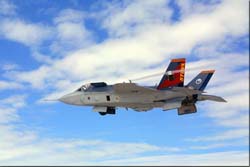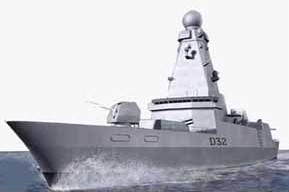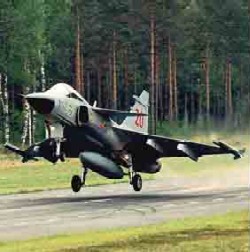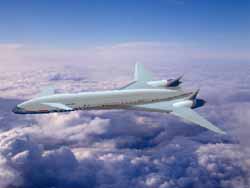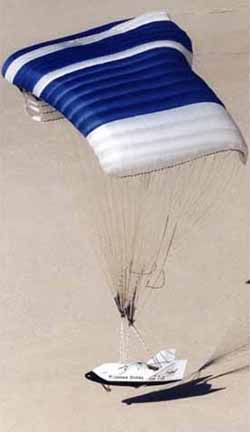Page 1
Daily News
By Gail Helmer
| Send Us News | Archives | Main |
Wednesday July 11, 2001
- JSF X-35B Converts to STOVL; Goes Supersonic
- BAE SYSTEMS Plagued With Losses Despite New Orders
- Gripen Outlines Partnership Programme For Poland
- Boeing's Sonic Cruiser Will Be A Good Neighbour Aircraft
- X-38 Flight Proves New Technologies For Space Rescues
Military News
JSF X-35B Converts to STOVL; Goes Supersonic
The Lockheed Martin Joint Strike Fighter X-35B engaged its short-takeoff/vertical landing (STOVL) system and made a supersonic dash in the same flight on Monday, July 9, near Edwards Air Force Base. Pilot Simon Hargreaves took off, climbed to 9,000 feet and successfully engaged the shaft-driven lift fan propulsion system at 180 knots. He then accelerated to an indicated Mach 1.08, marking the first time a JSF demonstrator has achieved a STOVL mode conversion and sustained supersonic flight in a single sortie.
The test marked the X-35B's first in-flight conversion to STOVL mode. Late last month, the aircraft completed 17 vertical takeoffs, hovers and vertical landings at the Lockheed Martin plant in Palmdale, Calif. Hargreaves flew the aircraft to Edwards on July 3 to begin the in-flight STOVL and conventional-flight testing series for the X-35B.
"By performing these missions that combine both STOVL and high-speed up-and-away objectives, we are demonstrating that the system we have designed, built and certified for flight can easily execute both flight modes in a single sortie," said Tom Burbage, executive vice president and general manager of the Lockheed Martin JSF program. "Our team will continue to expand the in-flight STOVL envelope in an aircraft that is essentially identical to the JSF we intend to produce for the armed forces of the United States and United Kingdom. The X-35B is in the same configuration it was when we performed our hover tests, and its configuration will remain unchanged throughout the flight-test program."
The X-35B features a unique propulsion system in which a drive shaft from the Pratt & Whitney JSF119-611 engine turns a counterrotating lift fan that produces cool-air lifting force during STOVL operations. The Rolls-Royce fan, actuated by a clutch that can be engaged at any power setting, works in concert with an articulating rear duct and under-wing lateral-control nozzles to lift the aircraft with nearly 40,000 pounds of vertical force. Because the fan amplifies the engine's power, the engine is able to run cooler and with less strain, increasing reliability and extending service life. The lift fan provides the propulsion system with about 10,000 pounds more thrust than the engine alone could generate.
All of the X-35B vertical takeoffs, hovers and landings were accomplished at 2,500 feet elevation, at temperatures up to 94 F. The Lockheed Martin team approach to the STOVL flight-test program is based on fielding and flying a demonstrator that solves the marginal thrust levels associated with direct-lift STOVL aircraft, so that both technical risk and cost are reduced before the JSF's production phase.
BAE SYSTEMS Plagued With Losses Despite New Orders
An announcement from UK Defence Secretary Geoff Hoon, revealing an acceleration in the D class Type 45 programme with BAE SYSTEMS as the prime contractor for the construction of three more of the new frigates, has not been enough to prevent the company from announcing job losses in its shipyards. Despite the contract, now worth £4.3 billion, BAe Systems have announced that 1,000 jobs will go in the Clydeside yards of Govan and Scotstoun, as well as 150 at the Barrow yard.
The original contract for three ships was placed in December 2000 and the government will now finalise this subsequent order in the next few months, three years ahead of schedule. The new Type 45 destroyers are to be built by BAE Systems Marine in association with Vosper Thorneycroft in Portsmouth. The contract should sustain 1,200 jobs at Clyde, 900 at Barrow and a further 650 with Vosper Thorneycroft.
"The strategy involves a commitment now to 6 ships of the planned class of up to 12 ships- doubling the number on order. This larger volume of guaranteed work and stable foundation to the project will allow industry to make long term investment decisions," said Mr. Hoon.
"This order alone secures some 2150 jobs on the Clyde and at Barrow, over and above our current workload. It will enable us to pursue our strategy of working with UK Government towards a meaningful long-term relationship," said Simon Kirby, Managing Director of BAE SYSTEMS Marine.
However, with the first ship not due to be delivered until 2007, and work on this contract not due to start in earnest until 2003, the announcement has not saved jobs in the short term. BAE SYSTEMS did attempt to counter the shortfall with an unspecified bid for two fuel supply ships, which was rejected by the Government, and have been further hampered by the postponement of a £140 million contract for 4 advanced landing craft for the MoD. The company will endeavour to minimise the effect of the cuts by offering early retirement, voluntary redundancy, and help with re-location.
"Unfortunately today's positive announcement concerning Type 45 has no impact on the short-term workload issues faced by our business. We have done everything we can to address this situation but regrettably have been left with no alternative other than to announce these redundancies," said Simon Kirby.
"Workers were expecting an announcement which would secure jobs, not result in 1,000 being axed. They were preparing to party but it has turned into a wake." said John Edmonds, general secretary of the GMB. While Henry McLeish, Scotland's First Minister did describe BAe's decision as "disappointing", he also pledged to continue working with the company. "BAe Systems is strengthening its position and investing in these shipyards and we will work with the company to further strengthen the skills base that will be needed in the years ahead," he said.
However, both the redundancies themselves and the cynical timing of the announcement have provoked an angry response from Union leaders and politicians alike.
"When we set out to secure the long-term future of the Clyde two-and-a-half years ago, we did not think we would have to pay a price like this," said Jamie Webster, the Govan union representative.
"We welcome all steps to safeguard shipbuilding jobs in the long-term, " said Angus Robertson MP, the SNP's defence spokesperson, "but that will be cold comfort to those 1,000 Clyde workers and their families who will lose their livelihoods, with their vital manufacturing skills also being lost."
With Britain's shipbuilding industry consistently under pressure this is another big blow. Despite the upbeat words of both the Defence Secretary and BAe systems with regard to the long-term future of warship construction, it is hard to see how the unions and communities can share their enthusiasm. Furthermore, it remains to be seen what effect diminishing morale and the loss of skilled workers will have on the productivity of Britain's shipyards.
Gripen Outlines Partnership Programme For Poland
Selection of the SAAB-BAE SYSTEMS Gripen new-generation, swing-role fighter to meet the national, NATO and European defense needs of Poland, would substantially boost the country's industrial base through a USD 3 billion programme of industrial co-operation and investment, the Anglo-Swedish partnership said in Warsaw today.
"The compensatory trade programme that would accompany the sale of Gripen to Poland would generate immediate and sustainable economic benefits through long-term industrial partnerships that others simply can not match," said Ray Lomas, who leads the Gripen marketing team in Poland. "The economic and industrial benefits would far exceed those offered by any of our competitors and more 'traditional' offset."
Targeted to meet specific business sector and regional priorities in line with Polish Government economic strategy, a compensatory trade agreement, which would accompany the sale of Gripen, would represent 100 per cent of the total contract value, the company confirmed.
Itwould create jobs and long-term growth in both the defense and commercial sectors, maximising economic benefits for Poland through inward investment, export promotion and technology transfer among others.
Together with its international supplier base, the Gripen team in Poland has spent the past five years understanding the needs of Polish industry and identifying potential industrial partners in a wide variety of sectors. This includes aerospace and defense, manufacturing and engineering, agriculture, banking and finance, environmental, utilities, communications, airfield development and education, among others.
In the process of this work, the Gripen team said long-term work packages and tenders worth almost US$60 million have already been placed with Polish companies and could grow naturally to almost US$130 million within the next five years.
"In Poland, SAAB-BAE SYSTEMS Gripen has done most to demonstrate the potential of its offset programmes," continued Lomas. "It is providing pre-contract jobs for local people, work for local factories and export revenues for the national economy. "
"Poland is already seeing the economic benefits of choosing SAAB-BAE SYSTEMS and its international industrial and financial network. Our projects, which fully meet the requirements of Polish offset law, are delivering important benefits to the national economy today. "
To date, Polish industry has been involved in manufacturing components and sub-assemblies for Hawk trainer, Gripen fighter and Avro RJ/RJX airliner projects. It has also produced tooling for use in the production of Eurofighter Typhoon, Nimrod, Airbus and Hawk aircraft.
Ammunition contracts have been awarded to Mesko and a partnership with Huta Stalowa Wola and Obrum is developing the 155mm Braveheart howitzer known as KRAB to meet both Polish and export requirements.
Boeing's Sonic Cruiser Will Be A Good Neighbour Aircraft
Boeing's potential new "sonic cruiser" aircraft will have fuel efficiency similar to today's long-range jets, and will offer several other environmentally-friendly advantages, said John Roundhill, Boeing Commercial Airplanes vice president of Marketing for the new aircraft program.
Speaking to members of the Royal Aeronautical Society, Roundhill addressed the environmental requirements of the proposed new aircraft.
"The sonic cruiser's fuel efficiency will be similar to the newest, similarly-sized aircraft being delivered today," he said.
Boeing also projects the proposed aircraft will have lower nitrogen oxide emissions than today's aircraft, Roundhill said. Local air quality near airports also should be improved because the aircraft's unique configuration and improved climb performance will mean less time spent in airport holding patterns.
Envisioned as a long-range aircraft linking more pairs of cities directly, the sonic cruiser will allow more direct flights. This, in turn, will mean fewer takeoff and landing cycles, greater fuel efficiency and a reduction in the associated emissions.
It also will reduce airport community noise, making it a "good neighbour" for those living near airports, Roundhill said. It will be quieter than upcoming Chapter 4 noise standards and current airport-specific requirements.
The proposed aircraft will fly at speeds of up to Mach .98 (approximately 98 percent of the speed of sound) or about 15 to 20 percent faster than current commercial jet aircraft. Higher cruising altitudes, in the mid-40,000-foot range, will offer a smoother, more comfortable ride and would allow the aircraft to fly over slower air traffic.
X-38 Flight Proves New Technologies For Space Rescues
An advanced X-38 prototype International Space Station "lifeboat" floated to a successful touchdown yesterday under the world's largest parafoil at NASA's Dryden Flight Research Centre at Edwards, Calif. This is the sixth free flight test for the X-38 project, ultimately intended to produce a vehicle capable of evacuating a seven-person crew from the station in an emergency.
The landing test, begun at an altitude of about 37,500 feet when the X-38 was released at 10:47 a.m. from NASA's B-52 aircraft, verified recent enhancements made to the X-38's flight control software. The flight also checked advances in the two-stage repositioning deployment of a drogue parachute that initially slows the vehicle from 600 miles an hour to about 60 miles an hour and sets the stage for deployment of the 7,500-square-foot-parafoil wing.The surface area of the parafoil is more than one and a half times that of the wings of a 747 jumbo jet.
Programme engineers continued testing European Space Agency-developed software that guides the parafoil, steering the X-38 to a safe landing. After a 13-minute gliding descent, the uncrewed X-38 touched down at a speed of less than 40 miles an hour on the clay surface of Rogers Dry Lake on Edwards Air Force Base in California's Mojave Desert.Several parafoil maneuvers were performed using the European-developed X-38 software.
"Each flight test of the X-38 incorporates technologies that have never before been used on a human spacecraft -- from satellite-based navigation to electromechanical actuators to the giant parafoil," said X-38 Crew Return Vehicle Programme Manager John Muratore. "Every flight gives us invaluable insight into the performance of these technologies during an actual descent and brings us closer to proving them for use in space."
The test was the second X-38 mission using the giant parafoil. The test also was the second flight of an X-38 shape that includes a semicircular cross section aft end, identical to the shape of an X-38 space vehicle planned for a test flight from a Space Shuttle in 2003 and now under construction.
The European-influenced semicircular aft end could allow the X-38 to be compatible with launch on a European Ariane V rocket as well as aboard the Space Shuttle.
The X-38 project is developing technologies that could be used to operate a prototype "lifeboat" for the International Space Station. The project combines proven technologies -- a shape borrowed from a 1970s Air Force project -- with some of the most cutting-edge aerospace technology available today.
Although the United States has led the development of the X-38, international space agencies also are participating. Contributing countries include Germany, Belgium, Italy, The Netherlands, France, Spain, Sweden and Switzerland.
NASA's Johnson Space Centre, Houston, Texas, leads the X-38 programme and is building the space-rated test vehicles.The X-38 atmospheric test vehicles were built by Scaled Composites, Mojave, Calif. NASA's Dryden Flight Research Centre flight tests the evolving X-38s. (Nasa Photo by Tom Txchida)
| Send Us News | Archives | Main |
